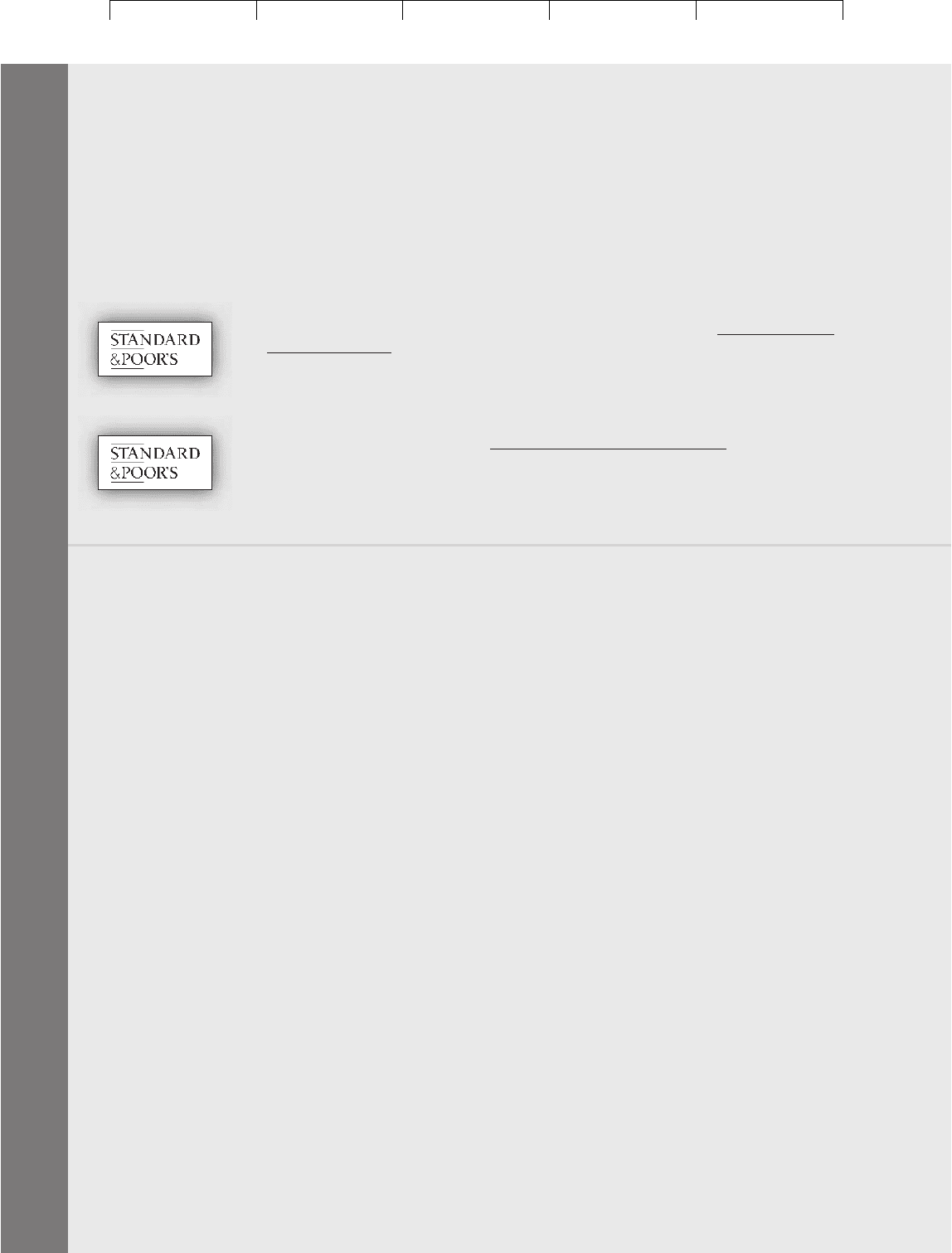Brealey, Myers. Principles of Corporate Finance. 7th edition
Подождите немного. Документ загружается.


Brealey−Meyers:
Principles of Corporate
Finance, Seventh Edition
IX. Financial Planning and
Short−Term Management
32. Credit Management
© The McGraw−Hill
Companies, 2003
The credit manager keeps a record of payment experiences with each customer.
Thus the manager knows that company Alpha always takes the discount and that.
Omega generally takes 90 days to pay. When a customer is in arrears, the usual pro-
cedure is to send a statement of account and to follow this at intervals with in-
creasingly insistent letters or telephone calls. If none of these has any effect, most
companies turn the debt over to a collection agency or an attorney. The fee for such
services is usually between 15 and 40 percent of the amount collected.
There is always a potential conflict of interest between the collection department
and the sales department. Sales representatives commonly complain that they no
sooner win new customers than the collection department frightens them off with
threatening letters. The collection manager, on the other hand, bemoans the fact
that the sales force is concerned only with winning orders and does not care
whether the goods are subsequently paid for.
There are also many instances of cooperation between sales managers and the
financial managers who worry about collections. For example, the specialty chem-
icals division of a major pharmaceutical company actually made a business loan to
an important customer that had been suddenly cut off by its bank. The pharma-
ceutical company bet that it knew its customer better than the customer’s bank did.
The bet paid off. The customer arranged alternative bank financing, paid back the
pharmaceutical company, and became an even more loyal customer. It was a nice
example of financial management supporting sales.
It is not common for suppliers to make business loans to customers in this way,
but they lend money indirectly whenever they allow a delay in payment. Trade
credit can be an important source of short-term funds for indigent customers that
cannot obtain a bank loan. But that raises an important question: If the bank is un-
willing to lend, does it make sense for you, the supplier, to continue to extend trade
credit? Here are two possible reasons why it may make sense: First, as in the case
of our pharmaceutical company, you may have more information than the bank
does about the customer’s business. Second, you need to look beyond the imme-
diate transaction and recognize that your firm may stand to lose some profitable
future sales if the customer goes out of business.
14
Factoring and Credit Insurance
A large firm has some advantages in managing its accounts receivable. There are
potential economies of scale in record keeping, billing, and so on. Also debt collec-
tion is a specialized business that calls for experience and judgment. The small firm
may not be able to hire or train a specialized credit manager. However, it may be
able to obtain some of these economies by farming out part of the job to a factor.
Factoring works as follows: The factor and the client agree on credit limits for
each customer and on the average collection period. The client then notifies each
customer that the factor has purchased the debt. Thereafter, for any sale, the client
sends a copy of the invoice to the factor, the customer makes payment directly to
the factor, and the factor pays the client on the basis of the agreed average collec-
tion period regardless of whether the customer has paid. There are, of course, costs
CHAPTER 32
Credit Management 919
14
Of course, banks also need to recognize future opportunities to make profitable loans to the firm.
The question therefore is whether suppliers have a greater stake in the continued prosperity of the
firm. For some evidence on the determinants of the supply and demand for trade credit, see M. A. Pe-
tersen and R. G. Rajan, “Trade Credit: Theories and Evidence,” Review of Financial Studies 10 (1997),
pp. 661–692.

Brealey−Meyers:
Principles of Corporate
Finance, Seventh Edition
IX. Financial Planning and
Short−Term Management
32. Credit Management
© The McGraw−Hill
Companies, 2003
920 PART IX Financial Planning and Short-Term Management
to such an operation, and the factor typically charges a fee of 1 to 2 percent of the
value of the invoice.
15
This factoring arrangement, known as maturity factoring, provides assistance
with collection and insurance against bad debts. Generally, the factor is also will-
ing to advance 70 to 80 percent of the value of the accounts at an interest cost of 2
or 3 percent above the prime rate. Factoring that provides collection, insurance,
and finance is generally termed old-line factoring.
16
Factoring is most common in industries such as clothing and toys. These indus-
tries are characterized by many small producers and retailers that do not have long-
established relationships with each other. Because a factor may be employed by a
number of manufacturers, it sees a larger proportion of the transactions than any sin-
gle firm and therefore is better placed to judge the creditworthiness of each customer.
17
If you don’t want help with collection but do want protection against bad debts,
you can obtain credit insurance. The credit insurance company obviously wants to
be certain that you do not throw caution to the winds by extending boundless
credit to the most speculative accounts. It therefore generally imposes a maximum
amount that it will cover for accounts with a particular credit rating. Thus it may
agree to insure up to a total of $100,000 of sales to customers with the highest Dun
and Bradstreet rating, up to $50,000 to those with the next-highest rating, and so
on. You may claim not only if the customer actually becomes insolvent but also if
an account is overdue. Such a delinquent account is then turned over to the insur-
ance company, which makes vigorous efforts to collect.
Most governments have established agencies to insure export credits. In the
United States this insurance is provided by the Export–Import Bank (Ex–Im Bank) in
association with a group of insurance companies known as the Foreign Credit In-
surance Association (FCIA). Banks are much more willing to lend against export
credits that have been insured.
15
Many factors are subsidiaries of commercial banks. Their typical client is a relatively small manufac-
turing company selling on a repetitive basis to a large number of industrial or retail customers.
16
Under an arrangement known as with-recourse factoring, the company is liable for any delinquent ac-
counts. In this case the factor provides collection, but not insurance.
17
This point is made in S. L. Mian and C. W. Smith, Jr., “Accounts Receivable Management Policy: The-
ory and Evidence,” Journal of Finance 47 (March 1992), pp. 169–200.
SUMMARY
Credit management involves five steps. The first is to establish normal terms of
sale. This means that you must decide the length of the payment period and the
size of any cash discounts. In most industries these conditions are standardized.
The second step is to decide the form of the contract with your customer. Most
domestic sales are made on open account. In this case the only evidence that the
customer owes you money is the entry in your ledger and a receipt signed by the
customer. Particularly if the customer is located in a foreign country, you may re-
quire a more formal contract. We looked at two such devices—the trade acceptance
and the letter of credit.
The third step is to assess each customer’s creditworthiness. There are a variety of
sources of information—your own experience with the customer, the experience of
other creditors, the assessment of a credit agency, a check with the customer’s bank,
the market value of the customer’s securities, and an analysis of the customer’s fi-
Visit us at www.mhhe.com/bm7e

Brealey−Meyers:
Principles of Corporate
Finance, Seventh Edition
IX. Financial Planning and
Short−Term Management
32. Credit Management
© The McGraw−Hill
Companies, 2003
CHAPTER 32 Credit Management 921
nancial statements. Firms that handle a large volume of credit information often use
a formal system for combining the data from various sources into an overall credit
score. Such numerical scoring systems help separate the borderline cases from the
obvious sheep or goats. We showed how you can use statistical techniques such as
multiple-discriminant analysis to give an efficient measure of default risk.
When you have made an assessment of the customer’s credit standing, you can
move to the fourth step in credit management, which is to establish sensible credit lim-
its. The job of the credit manager is not to minimize the number of bad debts; it is to
maximize profits. This means that you should increase the customer’s credit limit as
long as the probability of payment times the expected profit is greater than the prob-
ability of default times the cost of the goods. Remember not to be too shortsighted in
reckoning the expected profit. It is often worth accepting the marginal applicant if
there is a chance that the applicant may become a regular and reliable customer.
The fifth, and final, step is to collect. Doing so requires tact and judgment. You
want to be firm with the truly delinquent customer, but you don’t want to offend
the good one by writing demanding letters just because a check has been delayed
in the mail. You will find it easier to spot troublesome accounts if you keep a care-
ful record of the aging of receivables.
These five steps are interrelated. For example, you can afford more liberal terms
of sale if you are very careful about whom you grant credit to. You can accept
higher-risk customers if you are very active in pursuing any late payers. A good
credit policy is one that adds up to a sensible whole.
FURTHER
READING
A standard text on the practice and institutional background of credit management is:
R. H. Cole and L. Mishler: Consumer and Business Credit Management, 11th ed., McGraw-Hill,
New York, 1998.
For a more analytical discussion of credit policy, see:
S. Mian and C. W. Smith: “Extending Trade Credit and Financing,” Journal of Applied Corpo-
rate Finance, 7:75–84 (Spring 1994).
M. A. Peterson and R. G. Rajan: “Trade Credit: Theories and Evidence,” Review of Financial
Studies, 10:661–692 (1997).
Altman’s paper is the classic on numerical credit scoring:
E. I. Altman: “Financial Ratios, Discriminant Analysis and the Prediction of Corporate Bank-
ruptcy,” Journal of Finance, 23:589–609 (September 1968).
Altman also provides a review of credit scoring models in:
E. I. Altman: Corporate Financial Distress and Bankruptcy, 2nd ed., John Wiley, New York, 1993.
QUIZ
1. Company X sells on a 1/30, net 60 basis. Customer Y buys goods invoiced at $1,000.
a. How much can Y deduct from the bill if Y pays on day 30?
b. What is the effective annual rate of interest if Y pays on the due date rather than on
day 30?
c. How would you expect payment terms to change if
i. The goods are perishable.
ii. The goods are not rapidly resold.
iii. The goods are sold to high-risk firms.
2. The lag between the purchase date and the date on which payment is due is known as
the terms lag. The lag between the due date and the date on which the buyer actually
Visit us at www.mhhe.com/bm7e

Brealey−Meyers:
Principles of Corporate
Finance, Seventh Edition
IX. Financial Planning and
Short−Term Management
32. Credit Management
© The McGraw−Hill
Companies, 2003
922 PART IX Financial Planning and Short-Term Management
pays is the due lag, and the lag between the purchase and actual payment dates is the
pay lag. Thus,
State how you would expect the following events to affect each type of lag:
a. The company imposes a service charge on late payers.
b. A recession causes customers to be short of cash.
c. The company changes its terms from net 10 to net 20.
3. Complete the passage below by selecting the appropriate terms for each blank from the
following list (some terms may be used more than once): acceptance, open, commercial,
trade, the United States, his or her own, draft, account, bank, the customer’s, letter of credit,
shipping documents.
Most goods are sold on ______ ______. In this case the only evidence of the debt is
a record in the seller’s books and a signed receipt. If you wish to ensure that its buyer
will pay, you can arrange a(n) ______ ______ , ordering payment by the customer. In or-
der to obtain the ______ ______, the customer must acknowledge this order and sign
the document. The signed acknowledgment is known as a(n) ______ ______. Sometimes
the seller may ask ______ ______ bank to sign the document. In this case it is known as
a(n) ______ ______. The fourth form of contract is used principally in overseas trade.
The customer’s bank sends the exporter a(n) ______ ______ ______ stating that it has es-
tablished a credit in his or her favor at a bank in the United States. The exporter then
draws a draft on ______ bank and presents it to ______ ______ bank together with the
______ ______ and ______ ______. The bank then arranges for this draft to be accepted
and forwards the ______ ______ to the customer’s bank.
4. The Branding Iron Company sells its irons for $50 apiece wholesale. Production cost is
$40 per iron. There is a 25 percent chance that wholesaler Q will go bankrupt within the
next year. Q orders 1,000 irons and asks for six months’ credit. Should you accept the
order? Assume that the discount rate is 10 percent per year, there is no chance of a re-
peat order, and Q will pay either in full or not at all.
5. Look back at Section 32.4. Cast Iron’s costs have increased from $1,000 to $1,050. As-
suming there is no possibility of repeat orders, answer the following:
a. When should Cast Iron grant or refuse credit?
b. If it costs $12 to determine whether a customer has been a prompt or slow payer in
the past, when should Cast Iron undertake such a check?
6. Look back at the discussion in Section 32.4 of credit decisions with repeat orders. If ,
what is the minimum level of at which Cast Iron is justified in extending credit?
7. True or False?
a. Exporters who require greater certainty of payment arrange for the customers to
sign a bill of lading in exchange for a sight draft.
b. Multiple-discriminant analysis is often used to construct an index of
creditworthiness. This index is generally called a Z score.
c. It makes sense to monitor the credit manager’s performance by looking at the
proportion of bad debts.
d. If a customer refuses to pay despite repeated reminders, the company will usually
turn the debt over to a factor or an attorney.
e. The Foreign Credit Insurance Association insures export credits.
p
2
p
1
.8
Pay lag terms lag due lag
PRACTICE
QUESTIONS
1. Listed below are some common terms of sale. Can you explain what each means?
a. 2/30, net 60.
b. net 10.
c. 2/5, EOM, net 30.
Visit us at www.mhhe.com/bm7e

Brealey−Meyers:
Principles of Corporate
Finance, Seventh Edition
IX. Financial Planning and
Short−Term Management
32. Credit Management
© The McGraw−Hill
Companies, 2003
CHAPTER 32 Credit Management 923
Visit us at www.mhhe.com/bm7e
2. Some of the items in question 1 involve a cash discount. For each of these, calculate the rate
of interest paid by customers who pay on the due date instead of taking the cash discount.
3. Phoenix Lambert currently sells its goods cash on delivery. However, the financial man-
ager believes that by offering credit terms of 2/10 net 30 the company can increase sales
by 4 percent, without significant additional costs. If the interest rate is 6 percent and the
profit margin is 5 percent, would you recommend offering credit? Assume first that all
customers take the cash discount. Then assume that they all pay on day 30.
4. As treasurer of the Universal Bed Corporation, Aristotle Procrustes is worried about his
bad debt ratio, which is currently running at 6 percent. He believes that imposing a
more stringent credit policy might reduce sales by 5 percent and reduce the bad debt
ratio to 4 percent. If the cost of goods sold is 80 percent of the selling price, should
Mr. Procrustes adopt the more stringent policy?
5. Jim Khana, the credit manager of Velcro Saddles, is reappraising the company’s credit
policy. Velcro sells on terms of net 30. Cost of goods sold is 85 percent of sales, and fixed
costs are a further 5 percent of sales. Velcro classifies customers on a scale of 1 to 4. Dur-
ing the past five years, the collection experience was as follows:
Defaults as Percent Average Collection Period in Days
Classification of Sales for Nondefaulting Accounts
1.0 45
2 2.0 42
3 10.0 40
4 20.0 80
The average interest rate was 15 percent.
What conclusions (if any) can you draw about Velcro’s credit policy? What other
factors should be taken into account before changing this policy?
6. Look again at question 5. Suppose (a) that it costs $95 to classify each new credit applicant
and ( b) that an almost equal proportion of new applicants falls into each of the four cate-
gories. In what circumstances should Mr. Khana not bother to undertake a credit check?
7. Until recently, Augean Cleaning Products sold its products on terms of net 60, with an
average collection period of 75 days. In an attempt to induce customers to pay more
promptly, it has changed its terms to 2/10, EOM, net 60. The initial effect of the changed
terms is as follows:
Average Collection Periods, Days
Percent of Sales with Cash Discount Cash Discount Net
60 30* 80
*Some customers deduct the cash discount even though they pay after the specified date.
Calculate the effect of the changed terms. Assume
• Sales volume is unchanged.
• The interest rate is 12 percent.
•
There are no defaults.
• Cost of goods sold is 80 percent of sales.
8. Look back at question 7. Assume that the change in credit terms results in a 2 percent
increase in sales. Recalculate the effect of the changed credit terms.
9. Financial ratios were described in Chapter 29. If you were a credit manager, to which
financial ratios would you pay most attention? Which do you think would be the least
informative?
EXCEL
EXCEL

Brealey−Meyers:
Principles of Corporate
Finance, Seventh Edition
IX. Financial Planning and
Short−Term Management
32. Credit Management
© The McGraw−Hill
Companies, 2003
924 PART IX Financial Planning and Short-Term Management
10. Discuss the problems with developing a numerical credit scoring system for evaluating
personal loans. You can only test your system using data for applicants who have in the
past been granted credit. Is this a potential problem?
11. Discuss ways in which real-life decisions are more complex than the decision illustrated
in Figure 32.3. How do you think these differences ought to affect the credit decision?
12. How should your willingness to grant credit be affected by differences in (a) the profit
margin, (b) the interest rate, (c) the probability of repeat orders? In each case illustrate
your answer with a simple example.
13. Select two companies from the Market Insight database (www
.mhhe.com/
edumarketinsight). Use their latest financial statements to calculate some financial
ratios that throw light on their relative creditworthiness. Calculate a Z-score for each,
using the formula shown in Section 32.3. Now look at other indicators of creditwor-
thiness, such as the company’s bond rating or the return on its stock. Are the differ-
ent indicators providing consistent messages?
14. Use the Market Insight database (www
.mhhe.com/edumarketinsight) to compare the
average collection periods (see Section 29.3) for different companies. Can you explain
why some companies grant more credit than others?
CHALLENGE
QUESTIONS
1. Why do firms grant “free” credit? Would it be more efficient if all sales were for cash
and late payers were charged interest?
2. Sometimes a firm sells its receivables at a discount to a wholly owned captive finance
company. This captive finance company is partly financed by the parent, but it also is-
sues substantial amounts of debt. What are the possible advantages of such an
arrangement?
3. Reliant Umbrellas has been approached by Plumpton Variety Stores of Nevada. Plump-
ton has expressed interest in an initial purchase of 5,000 umbrellas at $10 each on Reliant’s
standard terms of 2/30, net 60. Plumpton estimates that if the umbrellas prove popular
with customers, its purchases could be in the region of 30,000 umbrellas a year. After de-
ductions for variable costs, this account would add $47,000 per year to Reliant’s profits.
Reliant has been anxious for some time to break into the lucrative Nevada market,
but its credit manager has some doubts about Plumpton. In the past five years, Plump-
ton had embarked on an aggressive program of store openings. In 2001, however, it
went into reverse. The recession, combined with aggressive price competition, caused
a cash shortage. Plumpton laid off employees, closed one store, and deferred store
openings. The company’s Dun and Bradstreet rating is only fair, and a check with
Plumpton’s other suppliers reveals that, although Plumpton traditionally took cash
discounts, it has recently been paying 30 days slow. A check through Reliant’s bank in-
dicates that Plumpton has unused credit lines of $350,000 but has entered into discus-
sions with the banks for a renewal of a $1,500,000 term loan due at the end of the year.
Table 32.1 summarizes Plumpton’s latest financial statements.
As credit manager of Reliant, how do you feel about extending credit to Plumpton?
4. Galenic, Inc., is a wholesaler for a range of pharmaceutical products. Before deducting
any losses from bad debts, Galenic operates on a profit margin of 5 percent. For a long
time the firm has employed a numerical credit scoring system based on a small num-
ber of key ratios. This has resulted in a bad debt ratio of 1 percent.
Galenic has recently commissioned a detailed statistical study of the payment
record of its customers over the past eight years and, after considerable experimenta-
tion, has identified five variables that could form the basis of a new credit scoring sys-
tem. On the evidence of the past eight years, Galenic calculates that for every 10,000 ac-
counts it would have experienced the following default rates:
Visit us at www.mhhe.com/bm7e

Brealey−Meyers:
Principles of Corporate
Finance, Seventh Edition
IX. Financial Planning and
Short−Term Management
32. Credit Management
© The McGraw−Hill
Companies, 2003
CHAPTER 32 Credit Management 925
Visit us at www.mhhe.com/bm7e
By refusing credit to firms with a low credit score (less than 80), Galenic calculates that
it would reduce its bad debt ratio to 60/9,160, or just under .7 percent. While this may
not seem like a big deal, Galenic’s credit manager reasons that this is equivalent to a de-
crease of one-third in the bad debt ratio and would result in a significant improvement
in the profit margin.
a. What is Galenic’s current profit margin, allowing for bad debts?
b. Assuming that the firm’s estimates of default rates are right, how would the new
credit scoring system affect profits?
c. Why might you suspect that Galenic’s estimates of default rates will not be
realized in practice? What are the likely consequences of overestimating the
accuracy of such a credit scoring scheme?
d. Suppose that one of the variables in the proposed scoring system is whether the
customer has an existing account with Galenic (new customers are more likely to
default). How would this affect your assessment of the proposal?
Credit Score under
Number of Accounts
Proposed System Defaulting Paying Total
Greater than 80 60 9,100 9,160
Less than 80 40 800 840
Total 100 9,900 10,000
2001 2000 2001 2000
Cash $ 1.0 $ 1.2 Payables $ 2.3 $ 2.5
Receivables 1.5 1.6 Short-term loans 3.9 1.9
Inventory 10.9 11.6 Long-term debt 1.8 2.6
Fixed assets 5.1 4.3 Equity 10.5 11.7
Total assets $18.5 $18.7 Total liabilities $18.5 $18.7
2001 2000
Sales $55.0 $59.0
Cost of goods sold 32.6 35.9
Selling, general, and administrative expenses 20.8 20.2
Interest .5 .3
Tax .5 1.3
Net income $ .6 $ 1.3
TABLE 32.1
Plumpton Variety
Stores: summary
financial statements
(figures in millions).

Brealey−Meyers:
Principles of Corporate
Finance, Seventh Edition
IX. Financial Planning and
Short−Term Management
32. Credit Management
© The McGraw−Hill
Companies, 2003
RELATED WEBSITES
For an introductory guide to understanding
financial statements see:
www
.ibm.com/investor/financialguide
For easy access to annual reports see:
www
.reportgallery.com
www
.prars.com
Downloadable software for short- and long-
term financial planning is available on:
www
.decisioneering.com
Journals with articles on short-term financial
management include:
www
.americanbanker.com
www
.intltreasurer.com
www
.treasuryandrisk.com
The Federal Reserve Bank sites are good general
sources of reference for short-term interest rates
and material on payment systems. See, for
example:
www
.federalreserve.gov
www.ny.frb.org
www.stls.frb.org
Sites on short-term debt markets include:
www.afponline.org (money market and
interest rate data)
www
.gecfosolutions.com
(GE Capital’s
website contains information on sources and
costs of short-term finance)
www
.ny.frb.org/pihome/addpub/credit.
pdf (a guide to sources of credit)
The websites of most major banks provide
material on cash management services. See, for
example:
www
.bankone.com
www
.bankofamerica.com
Other sites dealing with cash management
include:
www
.nacha.org
(material on electronic
payment)
www
.phoenixhecht.com (a comprehensive
website on cash management with useful links)
Some sites that are concerned with credit
management:
www
.creditworthy.com
(credit management)
www
.dnb.com
(examples of Dun and
Bradstreet credit reports, articles on credit
management, and an introductory guide to
understanding financial statements)
www
.ftc.gov/bcp/conline/pubs/credit/
scoring.htm (a guide to credit scoring)
www.nacm.org (contains links to sites on
credit-related issues)
PART NINE
RELATED
WEBSITES

Brealey−Meyers:
Principles of Corporate
Finance, Seventh Edition
X. Mergers, Corporate
Control, and Governance
33. Mergers
© The McGraw−Hill
Companies, 2003
CHAPTER THIRTY-THREE
928
MERGERS

Brealey−Meyers:
Principles of Corporate
Finance, Seventh Edition
X. Mergers, Corporate
Control, and Governance
33. Mergers
© The McGraw−Hill
Companies, 2003
THE SCALE AND pace of merger activity in the United States have been remarkable. In 2000, the peak of
the merger boom, U.S. companies were involved in deals totaling more than $1.7 trillion. Table 33.1 lists
just a few of the more important recent mergers, including several that involved overseas companies.
During these periods of intense merger activity, management spends significant amounts of
time either searching for firms to acquire or worrying about whether some other firm will acquire
their company.
A merger adds value only if the two companies are worth more together than apart. This chapter
covers why two companies could be worth more together and how to get the merger deal done if
they are. We proceed as follows.
• Motives. Sources of value added.
• Dubious motives. Don’t be tempted.
• Benefits and costs. It’s important to estimate them consistently.
• Mechanics. Legal, tax, and accounting issues.
• Takeover battles and tactics. We look back to several famous takeover battles. This history illus-
trates merger tactics and shows some of the economic forces driving merger activity.
• Mergers and the economy. How can we explain merger waves? Who gains and who loses as a re-
sult of mergers?
This chapter concentrates on ordinary mergers, that is, combinations of two established firms. We
keep asking, What makes two firms worth more together than apart? We assume mergers are un-
dertaken to cut costs, add revenues, or create growth opportunities.
But mergers also change control and ownership. Pick a merger, and you’ll almost always find that
one firm is the protagonist and the other is the target. The top management of the target firm usu-
ally departs after the merger.
Financial economists now view mergers as part of a broader market for corporate control. The ac-
tivity in this market goes far beyond ordinary mergers. It includes spin-offs and divestitures, where a
company splits off part of its assets and operations into an independent corporation. It includes re-
structurings, where a company reshapes its capital structure to change incentives for managers. It in-
cludes buyouts of public companies by groups of private investors.
When corporate control changes, the first questions to ask are: Who owns the business now? Who is
running it? How closely do the owners control the managers? What incentives do the managers now have?
Such questions take us well beyond the analysis of ordinary mergers. In this chapter we concen-
trate on mergers. In the next, we move on to the market for corporate control.
929
Acquiring Company Selling Company Payment ($ billions)
Vodafone Air Touch (UK) Mannesmann (Ger) 202.8
America Online Time Warner 106.0
Pfizer Warner-Lambert 89.2
Glaxo Wellcome (UK) SmithKline Beecham (UK/US) 76.0
Bell Atlantic GTE 53.4
Total Fina (Fr) Elf Aquitaine (Fr) 50.1
AT&T MediaOne 49.3
France Telecom (Fr) Orange (UK) 46.0
Viacom CBS 39.4
Chase Manhattan J.P. Morgan 33.6
Citigroup Associates First Capital 31.0
BP Amoco (UK) Atlantic Richfield 27.2
TABLE 33.1
Some important
mergers in 2000 and
2001.
Source: Mergers and
Acquisitions, various issues.
